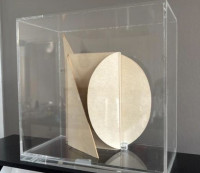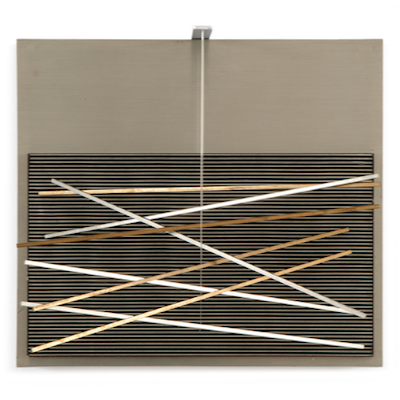
Details
Artist
Styles
white polyvinyl tape on painted panel in a box of the artist. Year ca. 1963–1971. Published: N. Leblanc, D. Everarts de Velp-Seynaeve, Walter Leblanc, Catalogue raisonné, Bruxelles, 1997, No. 564, p. 201. // PF 657 by Walter Leblanc, created around 1963–1971, is a mixed media artwork featuring white polyvinyl tape meticulously arranged on a painted panel. This piece exemplifies Leblanc's commitment to kinetic and optical art, where the interplay of light and shadow creates a dynamic, pulsating visual effect. The arrangement of the white strips forms a series of narrow, elongated diamond shapes that appear to shift as the viewer changes perspective. By using simple materials and a monochromatic palette, Leblanc achieves a sense of movement and depth, challenging perceptions of space and form. This work invites viewers to engage with its optical illusion, exploring how minimalistic elements can produce complex, engaging visual experiences.
PF 657
form
Medium
Size
40 x 40 cm
- Inches
- Centimeters
Edition
Price
- USD
- EUR
- GBP
Details
Artist
Styles
white polyvinyl tape on painted panel in a box of the artist. Year ca. 1963–1971. Published: N. Leblanc, D. Everarts de Velp-Seynaeve, Walter Leblanc, Catalogue raisonné, Bruxelles, 1997, No. 564, p. 201. // PF 657 by Walter Leblanc, created around 1963–1971, is a mixed media artwork featuring white polyvinyl tape meticulously arranged on a painted panel. This piece exemplifies Leblanc's commitment to kinetic and optical art, where the interplay of light and shadow creates a dynamic, pulsating visual effect. The arrangement of the white strips forms a series of narrow, elongated diamond shapes that appear to shift as the viewer changes perspective. By using simple materials and a monochromatic palette, Leblanc achieves a sense of movement and depth, challenging perceptions of space and form. This work invites viewers to engage with its optical illusion, exploring how minimalistic elements can produce complex, engaging visual experiences.
What is kinetic art?
Kinetic art is an international movement that emerged in the 1920s and gained prominence in the 1960s, referring to art that involves both apparent and real motion. It encompasses any medium that includes movement, either relying on actual motion for its effect or being perceived as moving by the viewer. Early examples include canvas paintings designed to create optical illusions of movement. Today, kinetic art often refers to three-dimensional figures and sculptures, such as those operated by machines or those that move naturally. The movement covers a variety of styles and techniques that frequently overlap.












